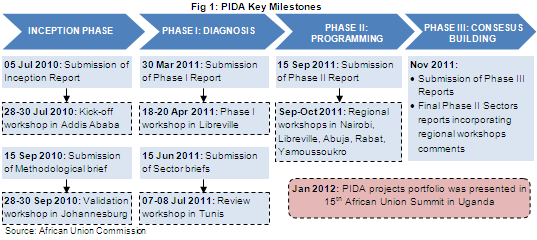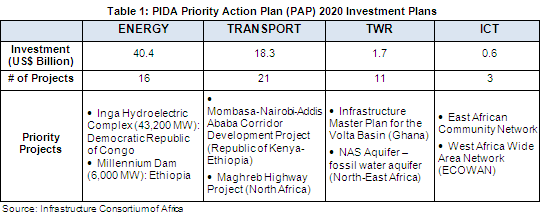「旬」なキーワードについての研究員解説
4th Research Department
氏名:Rashmi Jain
現在のアフリカ経済は活況を呈しており、特にアンゴラ、ナイジェリア、チャド、エチオピア、モザンビーク、ルワンダの6カ国は2000年から2010年までの10年間で世界トップ10位に入る高い経済成長率を達成している。一方、アフリカも他の新興国と同じくぜい弱なインフラが経済成長の足かせになりつつあり、インフラ改善がアフリカ諸国で喫緊の課題となっている。このような背景の中、アフリカ連合(AU)はアフリカ・インフラ開発プログラム(PIDA)と称するエネルギー、交通、水輸送、情報通信の4分野での開発計画を2012年から2040年にかけて策定。同プログラムではインフラ投資として同期間で3,600億ドルが拠出される予定であり、アフリカのインフラ関連事業でさまざまな機会を提供する見込み。
The lack of infrastructure in Africa has become an impediment for the fast-growing African economies to sustain their economic growth. It has also resulted in increased production and transaction costs, reduced business competitiveness, and negative impact on foreign direct investment across the continent. Hence, PIDA, a continent-wide program, was officially launched in July 2010 at the 15th Summit of the African Union, held in Kampala, Uganda.
The program was established to set up a strategic framework for the development of regional and continental infrastructure for Africa, by focusing on four priority sectors, Energy, Transport, TWR, and ICT. It is a long-term program divided into three phases: short-term goals (Priority Action Plan-PAP) to be achieved by 2020, medium-term goals by 2030, and long term goals by 2040.
Earlier, various continental infrastructure initiatives, such as NEPAD (New Partnership for Africa's Development) Short Term Action Plan, NEAD (Network for Evidence-to-Action on Disability) Medium to Long Term Strategic Framework (MLTSF), and AU (African Union) Infrastructure Master Plans were established to boost infrastructure development. Now, all these programs have been combined into PIDA to establish one coherent program with an objective to integrate strategic efforts among the 54 countries of the African continent.
The specific roles of the key entities are: the African Union is responsible for decision making, NEPAD will look after the project implementation, and AfDB will provide the funding support. The President of South Africa, Jacob Zuma, is the president of PIDA.
The overall PIDA 2040 vision aims to achieve the following:


The total investment is expected to be US$ 360 billion by 2040; out of which US$ 61 billion is projected under the Priority Action Plan (PAP) 2012-2020.
Under PAP, 50% of the total investments will be mobilized from the domestic sources, such as AfDB, national investment budgets, private sector financing (public-private partnerships and equity investments), ICA (Infrastructure Consortium for Africa), and emerging/development partners. The share of private sector financing is expected to reach 66% by 2030 and, further 75% by 2040.
The Millennium Dam is one of the key PIDA projects in the energy sector, which is under implementation. It is considered to be one of the largest hydroelectric power plants in Africa with an expected capacity of 6,000 MW, and is located on Blue Nile River, in the Benishangul-Gumuz Region of Ethiopia. On March 31, 2011, the project was awarded to an Italian company, Salini Costruttori (an EPC Contractor), for US$ 4.8 billion (without competitive bidding). The entire project will be funded by the Ethiopian government. Out of the total cost, the turbines and associated electrical equipment of the hydropower plants, costing about US$ 1.8 billion, will be financed by Chinese banks, and the remaining US$ 3 billion will be financed through bonds and other debt sources in Ethiopia.
The plant is expected to be commissioned by September 2014 to generate 15,000 GWh of electricity.
The major benefit of the dam will be hydro-electricity production, which will be shared by Ethiopia, Sudan, and Egypt. The dam is also expected to reduce flooding downstream in the countries.
The following benefits are expected from the successful implementation of the program:
However, the successful implementation of the program requires meeting certain challenges, such as coordination between high level AU and NEPAD stakeholders, smooth flow of financing from private as well as public sources, and individual countries' support for operation and maintenance.